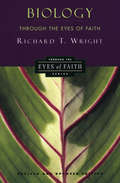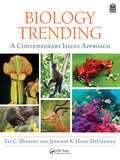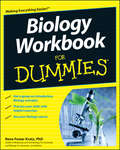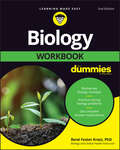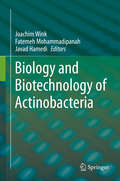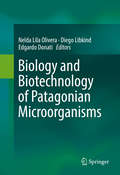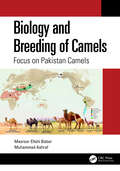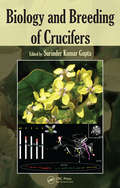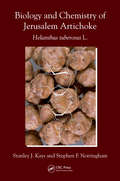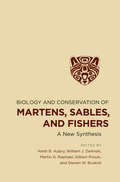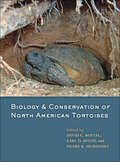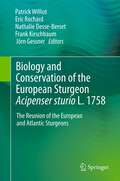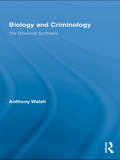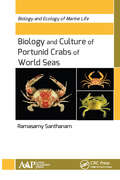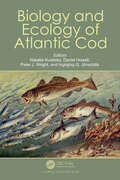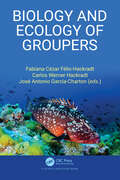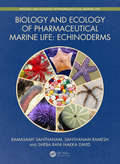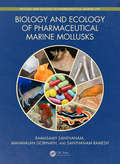- Table View
- List View
Biology Through the Eyes of Faith
by Richard T. WrightNewly Revised The Council of Christian Colleges and Universities Series Stressing the biblical message of stewardship, biologist Richard T. Wright celebrates the study of God's creation and examines the interaction of the life sciences with society in medicine, genetics, and the environment. The author brings a biblical perspective to theories on origins, contrasting creationism, intelligent design, and evolution. Highlighting the unique nature of biology and its interaction with Christian thought, Wright demonstrates that Christian stewardship can be the key to a sustainable future. This comprehensive work, one of a series cosponsored by the Council for Christian Colleges and Universities, addresses the needs of the Christian student of biology to align science and faith. It demonstrates that the study of biology penetrates to the core of human existence and has much to contribute to the construction of a consistent Christian worldview.
Biology Today
by David KirkBiology Today is a college-level biology textbook that went through three editions in 1972, 1975, and 1980. The first edition, published by Communications Research Machines, Inc. (CRM) and written by a small editorial team and large set of prominent "contributing consultants", is notable for its lavish illustrations and its humanistic approach. It was significantly rewritten by David L. Kirk and others for the second and third editions, which were issued by Random House.
Biology Trending: A Contemporary Issues Approach
by Eli Minkoff Jennifer K. Hood-DeGrenierBiology Trending is a truly innovative introductory biology text. Designed to combine the teaching of biological concepts within the context of current societal issues, Biology Trending encourages introductory biology students to think critically about the role that science plays in their world. This book features many current and relevant topics, including sea-level changes and ocean acidification; CRISPR/Cas9, opioid abuse, Zika, Ebola, and COVID-19; threats to biodiversity, and cancer immunotherapies. It is accompanied by digital Instructor and Student Resources to support teaching and learning.Key Features Adopts an "issues approach" to teaching introductory biology Up-to-date sections throughout, including climate change, CRISPR, new hominids, COVID-19, and new cancer therapies, among many others Suitable for both major and nonmajor courses More succinct for ease in teaching and more affordable for students High-quality illustrations help to elucidate key concepts This book is extended and enhanced through a range of digital resources that include: Long-form and open-response self-testing resources to test understanding and apply knowledge Visual simulations to demonstrate evolutionary processes Web links and bibliographic resources to expand knowledge Time-saving instructor resources such as PowerPoint slides, activity and assignment ideas, and comprehensive lesson plans Related TitlesBard, J. Evolution: The Origins and Mechanisms of Diversity (ISBN 9780367357016).Prothero, D. Vertebrate Evolution: From Origins to Dinosaurs and Beyond (ISBN 9780367473167)Johnson, N. A. Darwin’s Reach: 21st Century Applications of Evolutionary Biology (ISBN 9781138587397)
Biology Workbook For Dummies
by Rene Fester KratzFrom genetics to ecology -- the easy way to score higher in biologyAre you a student baffled by biology? You're not alone. With the help of Biology Workbook For Dummies you'll quickly and painlessly get a grip on complex biology concepts and unlock the mysteries of this fascinating and ever-evolving field of study.Whether used as a complement to Biology For Dummies or on its own, Biology Workbook For Dummies aids you in grasping the fundamental aspects of Biology. In plain English, it helps you understand the concepts you'll come across in your biology class, such as physiology, ecology, evolution, genetics, cell biology, and more. Throughout the book, you get plenty of practice exercises to reinforce learning and help you on your goal of scoring higher in biology. Grasp the fundamental concepts of biologyStep-by-step answer sets clearly identify where you went wrong (or right) with a problemHundreds of study questions and exercises give you the skills and confidence to ace your biology courseIf you're intimidated by biology, utilize the friendly, hands-on information and activities in Biology Workbook For Dummies to build your skills in and out of the science lab.
Biology Workbook For Dummies
by Rene Fester KratzGet a feel for biology with hands-on activities Biology Workbook For Dummies is a practical resource that provides you with activities to help you better understand concepts in biology. Covering all the topics required in high school and college biology classes, this workbook gives you the confidence you need to ace the test and get the grade you need. Physiology, ecology, evolution, genetics, and cell biology are all covered, and you can work your way through each one or pick and choose the topics where you could use a little extra help. This updated edition is full of new workbook problems, updated study questions and exercises, and fresh real-world examples that bring even the tough concepts to life. Get extra practice in biology with activities, questions, and exercises Study evolution, genetics, cell biology, and other topics in required biology classes Pass your tests and improve your score in high school or college biology class Demystify confusing concepts and get clear explanations of every ideaGreat as a companion to Biology For Dummies or all on its own, Biology Workbook For Dummies is your practice supplement of choice.
Biology and Biotechnology of Actinobacteria
by Joachim Wink Fatemeh Mohammadipanah Javad HamediThis book provides in-depth insights into the biology, taxonomy, genetics, physiology and biotechnological applications of Actinobacteria. It especially focuses on the latter, reviewing the wide variety of actinobacterial bioactive molecules and their benefits for diverse industrial applications such as agriculture, aquaculture, biofuel production and food technology. Actinobacteria are one of the most promising sources of small bioactive molecules and it is estimated that only a small percentage of actinobacterial bioactive chemicals have been discovered to date. Identifying new diverse gene clusters of biotechnological relevance in the genome of Actinobacteria will be crucial to developing advanced applications for pharmaceutical, industrial and agricultural purposes. The book offers a unique resource for all graduate students, researchers and practitioners in the fields of microbiology, microbial biotechnology, and the genetic engineering of Actinobacteria.
Biology and Biotechnology of Patagonian Microorganisms
by Nelda Lila Olivera Diego Libkind Edgardo DonatiThe Argentinean Patagonia offers a great diversity of scarcely explored environments suitable for the bioprospection of biotechnological relevant microorganisms. This book provides readers with a concise and clearly illustrated treatment of outstanding topics of Patagonian microbiology and biotechnology. It covers a wide range of areas interesting to several audiences such as researchers, graduate students and professionals working on the industry food. Among the main topics we will discuss examples of environmental applications, such as heavy metal and hydrocarbon bioremediation, bioprospection of valuable molecules from extremophilic bacteria and yeasts, the use of Patagonian yeasts and lactic acid bacteria in fermented foods and beverages, aquaculture probiotics and yeasts for food biopreservation.
Biology and Biotechnology of Quinoa: Super Grain for Food Security
by Ajit VarmaThis book is designed to popularize Quinoa cereal among both scientific and food industry. Quinoa is an attractive candidate for protein replacement, has potential for futuristic biotechnological modifications, and is able to grow under many different abiotic stresses. To save the world from animal cruelty, quinoa emerges as a hero for vegans and vegetarians. This book deals with morphological features, life cycle, nutritional qualities, genetics, agronomic manipulations, ecological communications, stress tolerance mechanisms, and food applications of Chenopodium quinoa. Quinoa is a pseudo-cereal native to Andes Region in South America. Over time, it spread to many different regions worldwide and is emerging as protein-rich vegetarian food source. In order to cure malnutrition globally, it is important to channel this lesser-known grain to local cultivators. This can only be done through well-proven scientific data that supports its qualities. This book aims to do the same, while also giving an insight into the vast scope quinoa posses as an experimental crop. Its stress-tolerant abilities can inspire scientists to understand those mechanisms, further exploit them, and even introduce them into other stress-sensitive crops. In future, quinoa can be among the top sources that offer food security. Due to its adaptability, ease of cultivation, and rich output, sustainability can be achieved by regulating its breeding and growth. This book is of interest to researchers, teachers, agronomic cultivators, environmentalists, botanists, microbiologists, geneticists and food technologists. This book covers recent advances, challenges in cultivation, biology, nutrition, and agricultural science topics, suitable for both young learners and advanced scientists. Cultivators who want to know more about quinoa and introduce it into their agronomic applications will find helpful information from the text.
Biology and Breeding of Camels: Focus on Pakistan Camels
by Muhammad Ashraf Masroor Ellahi BabarThis book discusses the biology, breeding, care, and management of camels, with a focus on camels from Pakistan. The book provides a sound understanding of how to look after camels, their senses, behavior, and adaptations. The chapters describe the practical aspects of camel husbandry such as how to maintain their body condition, feet, and cleanliness. It covers the types of feeds, feeding methods, and their needs at different stages of life. The book provides a detailed account of camel husbandry, breeding, and reproduction. It is meant for camel breeders, veterinarians, livestock advisers, students, and researchers working on animal sciences, camel rearing, feeding, and management. FEATURES Includes information about different species of camels present in Pakistan and their importance to humans Discusses the nutrition and feeding of camels, the medicinal qualities of camel milk, and the peculiar immunity-enhancing properties of their nutritious meat Describes the features of camels that help them survive and thrive in deserts and make them the animals of the future Covers the range of unique products obtained from camels and their economic value Explores the management, types of diseases in camels, causes of their spread, their control, and therapeutic measures for successful and productive farming
Biology and Breeding of Crucifers
by Surinder Kumar GuptaConsiderable interest has developed in recent years in crucifers and particularly in their wild relatives, as they contain genetic material that may be utilized for further evolution of superior crop varieties through introgression and distant hybridization. Until now, there has been no single volume that focuses exclusively on the biology and bree
Biology and Chemistry of Jerusalem Artichoke: Helianthus tuberosus L.
by Stanley J. Kays Stephen F. NottinghamA unique plant on many levels, the distinctive properties of the Jerusalem artichoke, or Helianthus tuberosus L., present novel answers to some of today's most pressing problems. The potential of Jerusalem artichoke as a source for inulin, a fructose polymer that may provide dietary health benefits for obesity, diabetes, and several other health is
Biology and Conservation of Horseshoe Crabs
by David Smith Mark L. Botton John T. TanacrediThe four living species of horseshoe crabs face a set of growing threats to their survival, including the erosion and/or man-made alteration of essential spawning habitat, coastal pollution, and overfishing. Horseshoe crabs are "living fossils", with a more than 200 million year evolutionary history. Their blood provides a reagent, known as Limulus amebocyte lysate or LAL, that clots in the presence of minute quantities of bacterial endotoxin; the LAL test is the state-of-the-art methodology used to ensure that pharmaceuticals and surgical implants are free of contamination. Horseshoe crabs are an integral part of the food web in coastal marine ecosystems, and their eggs provide essential food for shorebirds in the Delaware Bay estuary each spring. The commercial fishery for horseshoe crabs, which utilizes animals for bait, contributes to the economies of coastal communities. This book consists of papers presented at the 2007 International Symposium on the Science and Conservation of Horseshoe Crabs.
Biology and Conservation of Martens, Sables, and Fishers: A New Synthesis
by Steven W. Buskirk Martin G. Raphael Keith B. Aubry William J. Zielinski Gilbert ProulxMammals in the genus Martes are mid-sized carnivores of great importance to forest ecosystems. This book, the successor to Martens, Sables, and Fishers: Biology and Conservation, provides a scientific basis for management and conservation efforts designed to maintain or enhance the populations and habitats of Martes species throughout the world. The twenty synthesis chapters contained in this book bring together the perspectives and expertise of 63 scientists from twelve countries, and are organized by the five key themes of evolution and biogeography, population biology and management, habitat ecology and management, research techniques, and conservation.Recent developments in research technologies such as modeling and genetics, biological knowledge about pathogens and parasites, and concerns about the potential effects of global warming on the distribution and status of Martes populations make new syntheses of these areas especially timely. The volume provides an overview of what is known while clarifying initiatives for future research and conservation priorities, and will be of interest to mammalogists, resource managers, applied ecologists, and conservation biologists.
Biology and Conservation of North American Tortoises
by David C. Rostal, Earl D. McCoy, and Henry R. MushinskyThe most comprehensive book ever published on North America's native tortoises.Tortoises, those unmistakable turtles, evolved from a lineage that split off from the familiar pond turtles roughly 100 million years ago. Over time, these plant-eating land turtles spread around the world, growing to an enormous size (depending on the species) and living so long that they have become the stuff of legends. By most accounts, they are indeed the longest-lived of the turtles, with good records suggesting individuals may live as long as 180 years (anecdotal records suggest that some reach ages of 200 years or more).Providing the first comprehensive treatment of North America’s tortoises, Biology and Conservation of North American Tortoises brings together leading experts to give an overview of tortoise morphology, taxonomy, systematics, paleontology, physiology, ecology, behavior, reproduction, diet, growth, health, and conservation. The contributors carefully combine their own expertise and observations with results from studies conducted by hundreds of other researchers. The result is a book that belongs in the library of every herpetologist.ContributorsGustavo Aguirre L.Linda J. AllisonMatthew J. ArescoRoy C. Averill-MurrayJoan E. BerishKristin H. BerryDennis M. BrambleK. Kristina DrakeTaylor EdwardsTodd C. EsqueRichard FranzCraig GuyerJ. Scott HarrisonSharon M. HermannJ. Howard HutchisonElliott R. JacobsonValerie M. JohnsonRichard T. KazmaierEarl D. McCoyPhilip A. MedicaRobert W. MurphyHenry R. Mushinsky Kenneth E. NussearMichael P. O’ConnorThomas A. Radzio David C. RostalLora L. SmithJames R. SpotilaCraig B. StanfordC. Richard TracyTracey D. TubervilleMichael TumaThane Wibbels
Biology and Conservation of the European Sturgeon Acipenser sturio L. 1758: The Reunion of the European and Atlantic Sturgeons
by Eric Rochard Frank Kirschbaum Jörn Gessner Nathalie Desse-Berset Patrick WilliotThe book aims at synthesizing our current knowledge of Acipenser sturio and its management. This species, one of the most widespread sturgeon species all over Western Europe ranging from the Black Sea to the Baltic, is now on the verge of extinction. Major aspects of its biology and management, including mismanagement, are provided in a historic perspective. Similarly, the changes in the restoration programs (in situ and ex situ) initiated in France and Germany are presented. As the species occurred in sympatry with Acipenser oxyrinchus in Germany and Poland and very recently in France as well, a brief outlook on restoration-management programs of A. oxyrinchus are also provided for both North America and Northern European countries, namely Germany and Poland. As conservation-restoration actions go beyond scientific issues, non-governmental stakeholders and marine professional fishermen's organizations have also been asked to contribute, and the key role of a French-German cooperation plan is underlined. A part of the book is devoted to perspectives. Illustrations of the European sturgeon, mainly in photographs, but also in stamps and paintings, are presented.
Biology and Criminology: The Biosocial Synthesis (Routledge Advances in Criminology)
by Anthony WalshNumerous criminologists have noted their dissatisfaction with the state of criminology. The need for a new paradigm for the 21st century is clear. However, many distrust biology as a factor in studies of criminal behavior, whether because of limited exposure or because the orientation of criminology in general has a propensity to see it as racist, classist, or at least illiberal. This innovative new book by noted criminologist Anthony Walsh dispels such fears, examining how information from the biological sciences strengthens criminology work and both complements and improves upon traditional theories of criminal behavior. With its reasoned case for biological science as a fundamental tool of the criminologist, Walsh's groundbreaking work will be required reading for all students and faculty within the field of criminology.
Biology and Culture of Portunid Crabs of World Seas (Biology and Ecology of Marine Life)
by Ramasamy SanthanamBiology and Culture of Portunid Crabs of World Seas provides an abundance of valuable first-hand information about the diversity, biology, ecology culture of the portunid crabs of the word seas. Marine crabs play an important role directly or indirectly in the livelihood of millions of people around the world. They have been reported to make up about 20% of all marine crustaceans caught, farmed, and consumed worldwide. Among these marine crabs, portunid crabs or swimming crabs of the family Portunidae (Class: Crustacea; Order: Decapoda; Infraorder: Brachyura) assume greater significance in the marine industry owing to their delicate meat with nutritional qualities. Although, several species of portunid crabs are edible and commercially important, only a few species of Scylla and Portunus have been widely cultivated. This is largely due to the lack of information on the biology of portunid crabs. Keeping this in view, this new volume presents the biology and aquaculture of marine portunid crabs. This volume will be of great use for researchers and students of disciplines such as fisheries science, marine biology, aquatic biology and fisheries and zoology and will also serve as a standard reference for college, university, and research libraries around the world.
Biology and Ecology of Atlantic Cod
by Peter J. Wright Daniel Howell Nataliia Kulatska Ingibjörg G. JónsdóttirAtlantic cod is an important fish species in human history and continues to be a major influence on North Atlantic fisheries management, as stock collapses and recoveries impact coastal communities and shelf sea food webs. This book provides an overview of Atlantic cod biology and ecology, focussing on regional differences in life-history and stock dynamics that affect productivity and the challenges faced by management. By comparing the success of management approaches and the local influence of changing climate and food webs, the book highlights the different pressures facing stocks and identifies knowledge gaps across the species’ range.
Biology and Ecology of Earthworms
by Clive A. Edwards Norman Q. AranconBiology and Ecology of Earthworms is established as a key valuable text for students of agriculture, soil science, and soil invertebrate zoology and ecology. This is the 4th Edition of the popular textbook which reviews all aspects of earthworm biology and ecology. The book has been fully revised and updated throughout. Particular changes include: new treatments of earthworm taxonomy, diversity, migration and geographical distribution; interactions between earthworms and other soil organisms, especially microorganisms and soil-borne pests and diseases; as well as the importance of earthworms in organic waste management.
Biology and Ecology of Groupers
by Fabiana Cézar Félix-HackradtGroupers are fascinating charismatic fishes commonly found in reef habitats around the world that sustain a global multimillionaire fishery. They are an important top predator species and therefore of paramount ecological importance for reef systems' resilience. The book, Biology and Ecology of Groupers is an up-to-date review of the main bio-ecological topics involving worldwide groupers species oriented to the academic community and managers. It covers aspects of classification and phylogenetic relationships, geographical distribution, and life history related characteristics (Section I), including the major threats of groupers populations, case studies of successful management and comments about the future of groupers in our changing world (Section II).
Biology and Ecology of Pharmaceutical Marine Cnidarians (Biology and Ecology of Marine Life)
by Ramasamy Santhanam Santhanam Ramesh Gubbiyappa Shiva KumarThe first comprehensive book on the biology and ecology of pharmaceutical cnidarians, answering a need for more knowledge about the identification, biology, natural products and bioactivities of these living resources. Contributed by scientists of both marine biology and pharmacy disciplines. Identifies the correct marine species, shows the ecological parameters of that species, and explores its biological values with particular attention to primary and secondary metabolites or bioactive constituents. A useful supplementary text on Marine Biology and Pharmacology courses. Nearly 200 illustrations are produced in full color, providing a high-quality reference. This book provides the taxonomy, common name, global distribution, habitat, diagnostic features, and pharmaceutical compounds (along with their activities) of 200 species of marine cnidarians along with nearly 200 detailed illustrations in glorious color. The phylum Cnidaria (formerly Coelenterata) is a large, diverse, and ecologically important group of marine invertebrates which make up 40 percent of the biomass of the oceans. Marine invertebrates are the richest source of marine natural products with potential applications in the pharmaceutical and medical sectors, and it has been reported that over 3000 bioactive compounds have been described from this phylum alone, mostly in the last decade.
Biology and Ecology of Pharmaceutical Marine Life: Echinoderms (Biology and Ecology of Marine Life)
by Ramasamy Santhanam Santhanam Ramesh Sheba Rani Nakka DavidThe first comprehensive book on the biology and ecology of pharmaceutical echinoderms. Contributed by scientists of both marine biology and pharmacy disciplines. All reported echinoderm species producing secondary metabolites are dealt with. Previously known only as nutritional invertebrates, the contribution of the echinoderms as sources of secondary metabolites for therapeutic compounds is a topic ripe for exploration. All 200+ images are produced in full color. This book provides the taxonomy, common name, global distribution, habitat, diagnostic features and pharmaceutical compounds (along with their activities) of 150 species of ecinoderms along with over 200 detailed illustrations in glorious color. Among the biota of marine habitats, the echinoderms, which include sea stars (starfish), brittle stars and basket stars, sea urchins and sand dollars, sea cucumbers, and sea lilies or feather stars, are known for their importance as promising sources of bioactive compounds for development of pharmaceuticals. Their potential therapeutic applications have been growing rapidly in the treatment of many diseases.
Biology and Ecology of Pharmaceutical Marine Mollusks (Biology and Ecology of Marine Life)
by Ramasamy Santhanam Santhanam Ramesh Manavalan GobinathKey features: Serves as a standard reference for researchers, teachers and students of various disciplines such as Fisheries Science, Marine Biology, Life Sciences, Biotechnology, Natural Products, Biochemistry, and Pharmacy, their libraries, and as a valuable guide for pharmaceutical companies involved in the development of new drugs Presents the taxonomy, common name, global distribution, and habitat of 275 species of marine molluscs Provides the diagnostic features and pharmaceutical compounds (along with their chemical structure and activities) of 275 species of marine molluscs Includes more than 500 detailed illustrations Covers bivalves, gastropods, and cephalopods Biology and Ecology of Pharmaceutical Marine Molluscs is the first comprehensive book of its kind written by scientists from both the Marine Biology and Pharmacy disciplines to fill the long-felt need for a marine natural products book devoted exclusively to molluscs. The taxonomy, common name, global distribution, habitat, diagnostic features and pharmaceutical compounds (along with their activities) of 275 species of marine molluscs are given in this comprehensive work, with accompanying illustrations. Bioactive substances isolated from marine invertebrates such as poriferans, coelenterates, molluscs, echinoderms, bryozoans and tunicates have been reported to possess antiviral, antimicrobial, antiprotozoal, antifungal, antihelmintic and anticancer activities. Among the marine invertebrates, marine molluscs have significant commercial applications; for instance, as a source of food, ornaments and production of lime. A few species of molluscs have also been reported to act as scavengers in cleaning the environment and pollution indicators. Recently, many molluscan species have been identified as a potential source of secondary metabolites, having a wide range of pharmaceutical applications. This should be a standard reference for students, researchers and teachers of disciplines such as Pharmacy, Fisheries Science, Marine Biology, Life Sciences, Biotechnology and Biochemistry, as well as a valuable guide for pharmaceutical companies involved in the development of new drugs from marine molluscs.
Biology and Ecology of Pharmaceutical Marine Plants (Biology and Ecology of Marine Life)
by Ramasamy Santhanam Santhanam Ramesh Hafiz Ansar SuleriaKey features: A standard reference for researchers, teachers and students of Marine Biology, Fisheries Science, Botany/Plant Science, Biotechnology, Natural Products, and Pharmacy, their libraries A valuable guide for pharmaceutical companies involved in the development of new drugs from marine plants Presents the taxonomy, common name, global distribution, and habitat of 400 species of marine plants Provides the diagnostic features and pharmaceutical compounds (along with their chemical structure and activities) of 400 species of marine plants Includes more than 600 detailed illustrations Covers blue-green algae, green algae, brown algae, and red algae Marine plants such as algae (blue-green algae and seaweeds), seagrasses, mangrove plants, salt-tolerant or salt-loving plants (halophytes) and coastal sand dune plants are known to generate approximately 70% of oxygen on earth, and help regulate oxygen in the atmosphere. These plants are potential sources of nutrients and are also considered valuable for the development of new drugs owing to their unique bioactive compounds. This book provides the taxonomy, common name, global distribution, habitat, diagnostic features and pharmaceutical compounds (along with their activities) of 400 species of marine plants, accompanied by high quality illustrations. Biology and Ecology of Pharmaceutical Marine Plants is the first comprehensive book of its kind written by scientists from both the Marine Biology and Pharmacy disciplines to fill the long-felt need for a marine natural products book devoted exclusively to plants. It should be a standard reference for students, researchers and teachers of disciplines such as Pharmacy, Fisheries Science, Marine Biology, Life Sciences, Biotechnology and Biochemistry, as well as a valuable guide for pharmaceutical companies involved in the development of new drugs from marine plants.

